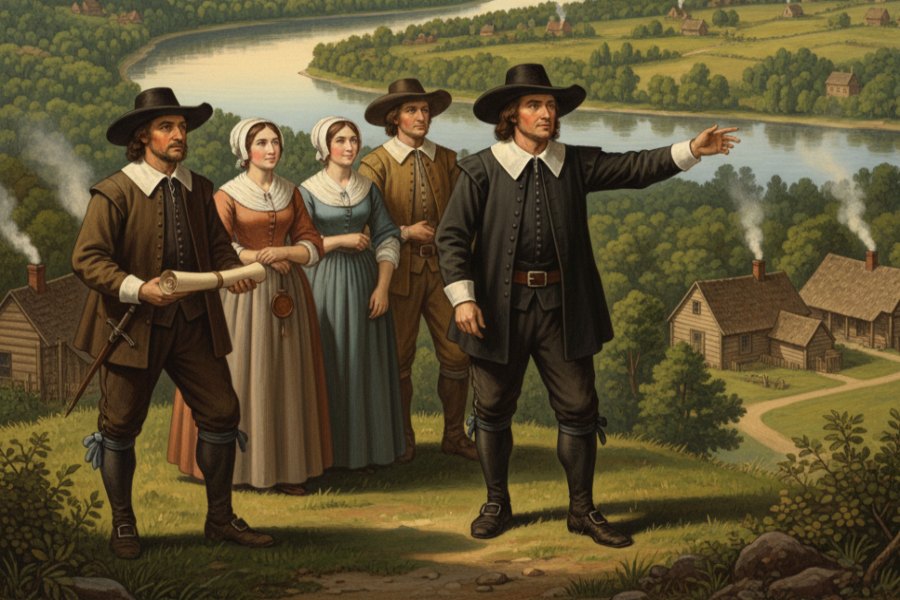
Have you ever wondered why a landlocked New England state shares its nickname with a tropical spice more at home in an Indonesian archipelago? Connecticut, often overshadowed by its flashier neighbors like New York and Massachusetts, harbors a moniker that’s equal parts quirky and controversial: “The Nutmeg State.” While the state’s official title is “The Constitution State,” celebrating its pivotal role in American governance, the Nutmeg label sticks like a well-seasoned roux. It’s a nod to a bygone era of Yankee ingenuity—or infamy—where shrewd traders allegedly peddled wooden fakes of the precious spice to wide-eyed customers down South.
But is this just colorful folklore, or does it reveal something deeper about Connecticut’s entrepreneurial spirit? In this deep dive, we’ll grate away the myths, explore the historical hustle, and sprinkle in some modern flavor. From 19th-century peddlers to today’s self-proclaimed “Nutmeggers,” the story of this nickname is a testament to how a kernel of truth can grow into a full-blown legend. Buckle up, history buffs and spice enthusiasts alike—we’re about to embark on a 2,000-word journey through time, trade, and a touch of trickery.
The Rise of Yankee Peddlers: Setting the Stage
To understand why Connecticut earned its spicy sobriquet, we must first step back to the 18th and 19th centuries, when the state was a hotbed of itinerant commerce. Connecticut’s geography—riddled with rivers, ports like New Haven and New London, and a population of resourceful farmers and artisans—fostered a culture of mobility and mercantilism. The Industrial Revolution hadn’t yet mechanized everything, so many young men (and some women) hit the roads as peddlers, hawking everything from tinware to textiles across the young United States.
Who Were the Yankee Peddlers?
Yankee peddlers were the unsung hustlers of early America, often hailing from Connecticut, Massachusetts, and Rhode Island. These weren’t your modern door-to-door salespeople with glossy brochures; they were rugged entrepreneurs with horse-drawn wagons loaded with oddities and necessities. Picture a grizzled trader in a woolen coat, bartering bolts of cloth for farm-fresh eggs or swapping pocket watches for homespun yarn. Connecticut’s peddlers, in particular, gained a reputation for their silver tongues and sharp deals. They weren’t just sellers; they were storytellers, convincing skeptical farmers that a Connecticut-made clock would tick truer than one from Philadelphia.
This reputation wasn’t entirely flattering. Southerners, who often viewed these Northern interlopers with a mix of amusement and suspicion, dubbed them “Yankee traders” for their knack for turning a profit on the slimmest margins. As one historian notes, these peddlers “roamed the Connecticut carriage roads during the 19th Century,” but their trails extended far beyond state lines, snaking through Virginia, the Carolinas, and even into the Deep South. Their wagons creaked under the weight of not just goods, but the weight of expectation: deliver value, or risk a tarnished name.
The 18th and 19th Century Trade Routes
Connecticut’s trade networks were as intricate as a nutmeg’s veined interior. The state didn’t grow nutmeg—Myristica fragrans, the evergreen tree behind the spice, thrives in tropical climes like Indonesia and Grenada—but it mastered the import game. Early sailors from ports like Mystic returned from global voyages with sacks of the aromatic seeds, which were ground into powder for everything from eggnog to pain relief (nutmeg was once a folk remedy for everything from insomnia to indigestion).
By the late 1700s, after the Revolutionary War, Connecticut’s economy boomed with smuggling and legitimate trade. Nutmeg, controlled by Dutch monopolies until the British seized the Banda Islands in 1796, was a luxury item fetching high prices. Peddlers bought wholesale in New York or Boston, then resold retail in rural markets. This arbitrage fueled the state’s growth, but it also bred envy. As trade routes expanded southward via the Post Road and emerging canals, Connecticut goods flooded markets, sometimes at suspiciously low prices. Whispers of counterfeit wares began to circulate, setting the stage for the nutmeg scandal that would define the state’s image.
In essence, Yankee peddlers weren’t just merchants; they were cultural ambassadors—and occasional antagonists—in America’s economic patchwork. Their journeys laid the groundwork for a nickname that would outlast the wagons themselves.
The Nutmeg Mystery: Fact or Fiction?
At the heart of the Nutmeg State lore lies a tantalizing tale: crafty Connecticut traders, desperate for profit, carving wooden replicas of nutmeg seeds and palming them off as the real deal. These faux nuts, whittled from cheap hardwood and stained to mimic the spice’s mottled brown exterior, were supposedly mixed into barrels of genuine product. Unsuspecting buyers, grating what they thought was premium seasoning, would discover splinters instead of savor. The story paints Nutmeggers as master deceivers, turning a simple seed into a symbol of Yankee guile.
The Legend of Wooden Nutmegs
The wooden nutmeg yarn first gained traction in the mid-19th century, amid a wave of anti-Yankee sentiment in Southern periodicals. Imagine a dusty Southern marketplace: a peddler unloads his cart, extolling the virtues of his “finest Connecticut nutmegs.” A buyer bites—literally—and chokes on what turns out to be lumber. The deception wasn’t just about nutmeg; peddlers were accused of faking everything from brass candlesticks (painted wood) to tea (dried leaves from local bushes). But nutmeg, small and unassuming, made for the perfect punchline.
This legend wasn’t born in a vacuum. Nutmeg’s value amplified the stakes; a pound could cost as much as a week’s wages. Peddlers, facing slim margins on long hauls, might have been tempted to stretch their stock. As one account recounts, these “resourceful but disingenuous peddlers” purportedly sold the wooden imposters “to unsuspecting customers for profit.” The ruse, if true, was ingenious: nutmegs are already woody, dense kernels that don’t shatter like nuts. A skilled carver could pass them off until the grating revealed the fraud.
The Samuel Slick Connection
Enter Samuel Slick, the fictional clockmaker created by Canadian judge Thomas Chandler Haliburton in the 1830s. Slick, a down-to-earth Nova Scotian with a drawl full of folksy wisdom, starred in serialized columns like “The Sayings and Doings of Samuel Slick, of Slickville.” In one 1840s installment, “The Preacher that Wandered from His Text,” Slick spins a yarn about Captain John Allspice of Nahant—a stand-in for Connecticut—stuffing barrels with wooden nutmegs so lifelike “you couldn’t tell ’em from real ones till you bit into ’em.”
Haliburton’s tales, published in the Novascotian and later American papers, popularized the trope. Slick’s accusations weren’t outright malice; they were satirical jabs at Yankee sharpness. By the 1870s, “wooden nutmegs” had become shorthand for any shoddy knockoff, with Connecticut as the implied culprit. As George Earlie Shankle’s 1941 book “State Names, Flags, Seals, Songs, Birds, Flowers, and Other Symbols” put it, the nickname arose because Connecticuters were “so ingenious and shrewd that they were able to make and sell wooden nutmegs.”
Evidence – Or Lack Thereof
Here’s the rub: for all the smoke, there’s scant fire. Historians like Natalie Belanger of the Connecticut Historical Society admit, “It’s not really clear if anybody did that… or if it originated in the idea that Yankee peddlers were so good at their business that they would be able to sell you a wooden nutmeg.” No archaeological digs have unearthed troves of carved nutmegs, and contemporary accounts are mostly anecdotal or secondhand. The story may be apocryphal, a literary invention that ballooned into legend, much like Paul Bunyan’s blue ox.
Yet, the absence of proof hasn’t dimmed the charm. As Belanger adds, “I just like it because it’s funny.” In a nation built on tall tales, the wooden nutmeg endures as a badge of cleverness, not criminality.
Alternative Theories: Did Southerners Get It Wrong?
What if the real culprits weren’t the peddlers, but the buyers? This counter-narrative flips the script, suggesting the “wooden nutmeg” slur stemmed from cultural misunderstandings rather than outright fraud.
The Grating Misunderstanding
Nutmeg isn’t your average nut. Unlike walnuts or pecans, which crack open to reveal a soft interior, the nutmeg seed is a solid, rock-hard pit encased in a lacy aril (mace) and a fleshy fruit. Proper use? Grating it fresh over food for maximum aroma. But in the antebellum South, where imported spices were novelties, many households treated nutmeg like a nut to be bashed with a hammer.
Elizabeth Abbe, writing in a 1980 issue of Connecticut Magazine, proposed that “unknowing buyers may have failed to grate nutmegs, thinking they had to be cracked like a walnut. Since nutmegs are wood and bounce when struck, Southern customers, unaware of how to use them, may very well have accused the Yankees of selling useless ‘wooden’ nutmeg.” Imagine the scene: a frustrated plantation wife swings a mallet, the seed pings off the counter unscathed, and she cries foul— “These Yankees sold me wood!”
This theory aligns with broader patterns of regional friction. Southerners, reliant on cash crops like cotton, often bought Northern sundries sight-unseen. Without culinary know-how, a legitimate nutmeg could pass for a dud. Peddlers, ever adaptive, might have leaned into the complaint, joking about their “hardwood specials” to defuse tension. It’s a more benign explanation, transforming deception into a comedy of errors.
While not definitive, this view humanizes the tale. It reminds us that stereotypes often arise from crossed wires, not malice—though in the case of Yankee traders, a dash of both likely spiced the pot.
Beyond Nutmeg: Other Clever Tricks of CT Traders
The wooden nutmeg wasn’t a solo act; it was part of a repertoire of rumored ruses that burnished Connecticut’s image as a den of deal-makers. Peddlers allegedly passed off painted pebbles as buttons, willow twigs as tea leaves, and gutta-percha (a rubbery gum) as choice cheeses. One apocryphal story claims they sold “Connecticut clocks” that were little more than painted rocks with hands—until the buyer realized the “ticks” were imaginary.
These tales, while exaggerated, underscore a real Yankee virtue: innovation under constraint. Connecticut’s rocky soil and harsh winters forced farmers to improvise, birthing industries like clock-making (Eli Terry’s interchangeable parts revolutionized timepieces) and textiles. Peddlers were the mobile R&D arm, testing markets and refining pitches. As one source notes, “It is from peddlers’ sale of nutmeg that Connecticut received one of its nicknames, ‘the Nutmeg State.’ Legend holds that crafty peddlers would carve wooden nutmegs and sell them as the real thing.”
In truth, these “tricks” were survival tactics in a cutthroat economy. They highlight how Connecticut’s underdog status—small, sandwiched between giants—bred a scrappy ethos that still echoes in Silicon Valley transplants from the state.
The Nickname’s Evolution and Official Status
By the late 1800s, “Nutmeg State” had percolated into almanacs and atlases, appearing in print as early as 1875. It gained traction during the Gilded Age, when industrial booms made Connecticut a manufacturing powerhouse. The term evoked not just mischief, but mastery—a state so savvy it could alchemize wood into wealth.
When Did “Nutmeg State” Catch On?
The nickname’s first widespread use ties back to post-Civil War boosterism. Newspapers like the Hartford Courant ran tongue-in-cheek editorials embracing the label, turning insult into endearment. By 1900, it was unofficial canon, alongside monikers like “The Land of Steady Habits” for the state’s Puritan roots.
Constitution State vs. Nutmeg State
Officially, Connecticut is “The Constitution State,” a title voted in 1959 to honor the 1639 Fundamental Orders of Connecticut—the world’s first written constitution, predating Westminster by decades. This nod to governance suits the state’s legacy of blue laws and town meetings. Yet, Nutmeg persists as the populist pick. Polls show Nutmeggers favor its whimsy; as Belanger quips, it’s more memorable than legalese.
The duality reflects Connecticut’s split personality: buttoned-up and bold, pious and playful.
Modern Nutmeggers: Embracing the Legacy
Today, over three million Nutmeggers carry the torch with pride. The nickname infuses local lore, from the University of Connecticut’s “Nutmeg State Games” to artisanal spice blends at farmers’ markets. Hartford’s Daily Nutmeg magazine even claims the mantle, dishing out city stories with a spicy twist.
Nutmeg in CT Culture Today
Festivals like the Nutmeg Festival in Bristol celebrate with wood-carving demos (tongue firmly in cheek) and grating contests. Tourism boards lean in, touting “Yankee ingenuity tours” through peddler haunts like Litchfield County. And in politics? Candidates still invoke the “Nutmeg spirit” for that edge of clever compromise.
Fun Facts and Trivia
- Nutmeg High: The spice’s hallucinogenic properties (in massive doses) inspired tales of “nutmegged” Yankee visions—though that’s likely bunk.
- Famous Nutmeggers: From Katharine Hepburn (who grated her own) to Meryl Streep, celebs embrace the tag.
- Spice Smuggling: CT’s nutmeg trade once skirted British monopolies, making early traders proto-pirates.
- No Wood, All Win: Modern CT leads in aerospace and insurance—shrewd trades, minus the splinters.
These nuggets keep the legend alive, proving a good story outlasts a good scam.
Conclusion: A Spice of Life
Connecticut’s Nutmeg State nickname, whether born of wooden whimsy or grating gaffes, captures the essence of a state that’s always punched above its weight. It’s a reminder that history isn’t dry dates but flavorful fables—lessons in resilience wrapped in ridicule. Next time you sprinkle nutmeg on your pumpkin pie, tip your hat to the Nutmeggers who turned a tropical import into timeless lore. After all, in the words of Samuel Slick himself, “A lie well stuck to is as good as the truth.” Or, in Connecticut terms: close enough for government work.




